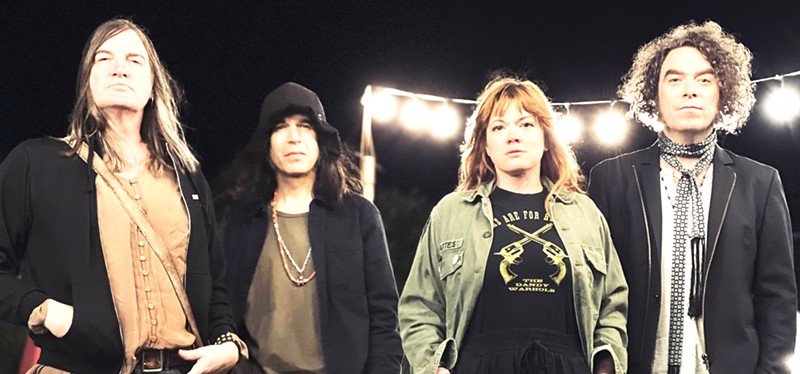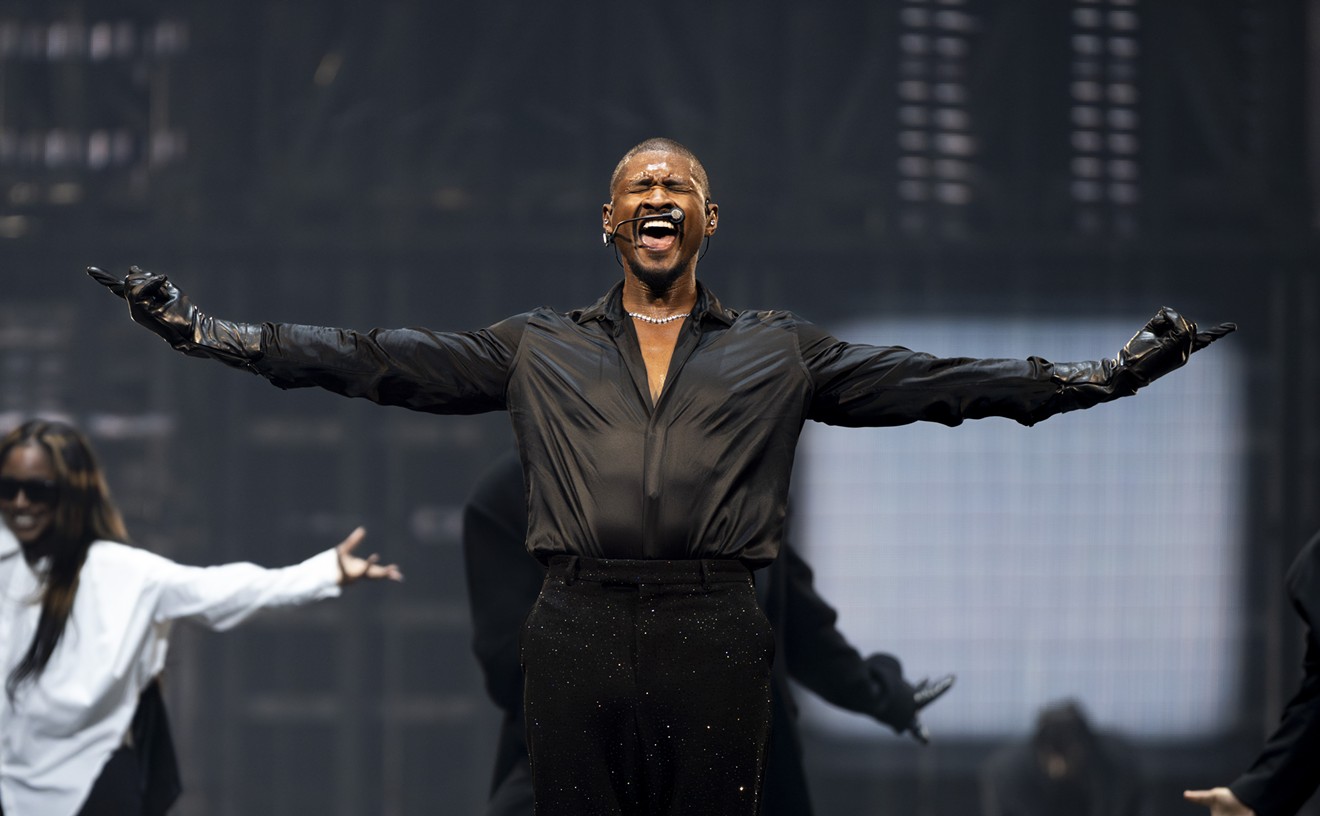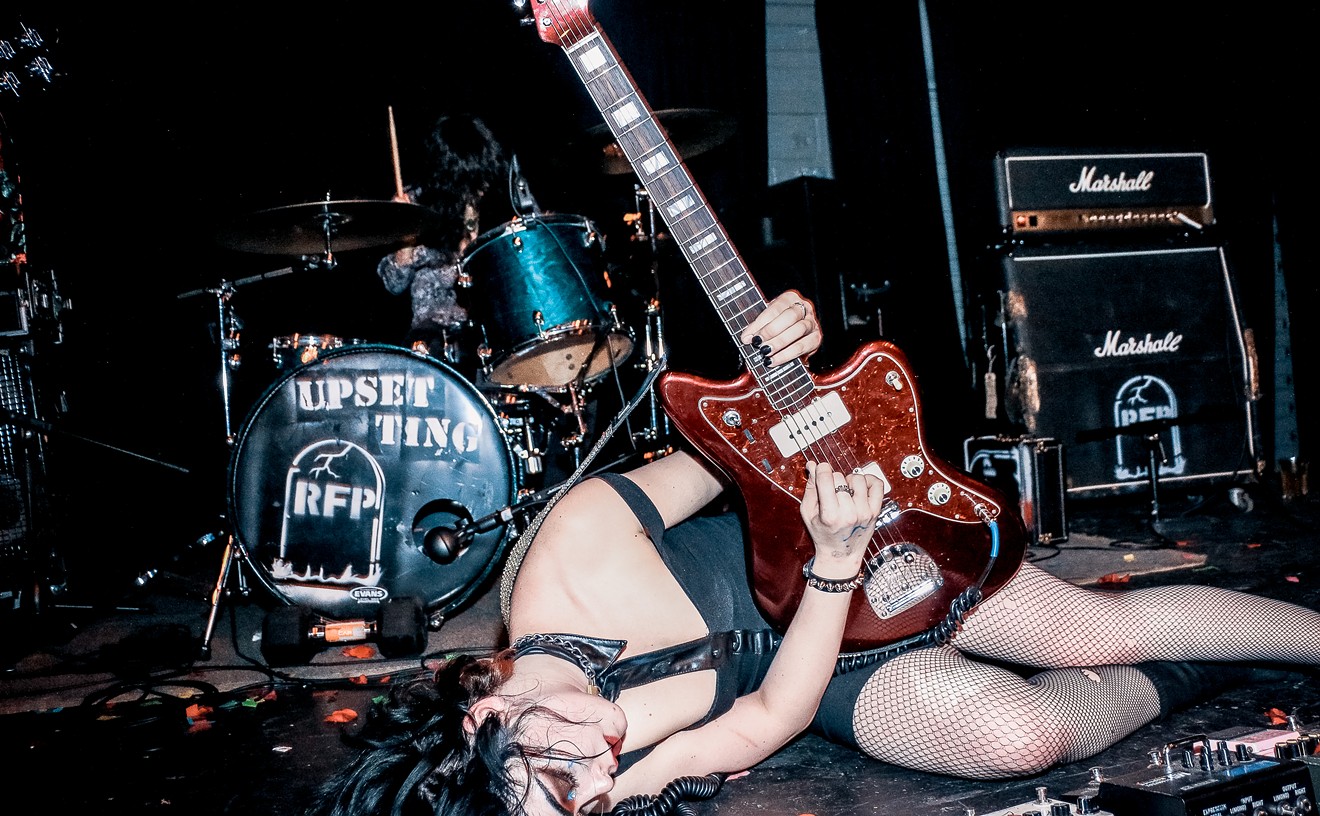For some, The Dandy Warhols have served as a kind of gateway drug or coming-of-age catalyst to a particular period of American counterculture. Their work has paid homage to American writers such as Kurt Vonnegut, musicians such as Lou Reed and historical events such as the sinking of the SS Edmund Fitzgerald. According to singer-songwriter Courtney Taylor-Taylor, this cultural curiosity has always been part of the band’s makeup.
"That’s kind of the idea of psychedelic music in the first place,” Taylor-Taylor says ahead of the band's concert at Ferris Wheelers Backyard and BBQ with The Black Angels on Wednesday, Oct. 25. “It’s supposed to open some doors. It’s not conscious, it’s just naturally built into the system. We’re all pretty overeducated.”
The Dandy Warhols consist of Taylor-Taylor, guitarist Peter Holmström, synth-bassist Zia McCabe and drummer Brent DeBoer. Unlike many bands fronted by such a strong personality, the long-running success of The Dandy Warhols may be attributed to the way each member’s unique contributions and individual personas are showcased seamlessly by a cohesive group project. Listening through the band's 28-year catalog, it’s hard to find two similar albums, both sonically and in lyrical composition. According to longtime guitarist and group co-founder Holmström, when creating music, the Dandy Warhol ideology has stayed consistent since the group’s inception.
“We’re just entertaining ourselves when it comes down to it,” Holmström says. “Musically there’s gaps that need to be filled, and that’s what we are all interested in. It’s always been that way and it seems to keep working.”
Before joining the band, Holmström attended New York University and studied studio art. Upon returning to Portland after hanging around New York for a year after graduation, he and Taylor-Taylor constructed the foundation that was to become The Dandy Warhols. McCabe joined shortly after meeting Taylor-Taylor at a local coffee shop, and DeBoer, who is Taylor-Taylor’s cousin, replaced original drummer Eric Hedford in 2000.
The band’s first record, Dandy’s Rule Ok, released in 1995 on Tim/Kerr Records, contains several tracks unapologetically named after bands and musicians that directly inspired them, such as “Ride” and “(Tony, This Song Is Called) Lou Weed." This approach to reveling in their inspiration was an ethos that Holmström learned while attending NYU art school and one he shared with Taylor-Taylor upon his return.
"We are always mining the past. I don’t know if there’s any other way to make music at this point but to mine the past," Taylor-Taylor says.
In fact, he was once told by a rock icon that he had this ability.
"Someone once asked David Bowie about the genius of Courtney Taylor-Taylor and Bowie responded, ‘The genius of Taylor-Taylor is his ability to mine the past,’" the singer says. "David was a deeply analytical and unconfused thinker. It’s weighed heavy on me ever since and that’s why if you rehash the old stuff, you should own up to it. That’s why [song] ‘Ride’ is called ‘Ride,’ [like the British band], ‘Lou Reed’ is ‘Lou Weed,’ and so on.”
Although The Dandy Warhols have found literature canon and rock n’ roll icons to be areas of inspiration, the group’s work stays firmly rooted in the present, creating a flexible pastiche of sorts that remains relative to the near future. The band’s latest single, “Summer of Hate,” penned about the civil unrest in the during the summer of 2020, embodies a political spirit centered in the human condition. The recently released music video for the single was created through the extensive use of AI technology. It's a hot topic of debate, and Taylor-Taylor and Holmström have several different viewpoints on the use of artificial intelligence.
“I don’t know if I’ve been super concerned about it,” Holmström says. “I don’t know how it affects me just quite yet. One thing I say is that AI takes from the past and artists aren’t getting their due credit for it.”
The “Summer of Hate” music video may also be a statement piece relevant to the current discourse on the ethical implications of AI. In true psychedelic fashion, the distorted images of each member’s face and clothing change and oscillate throughout the course of the song, creating a kind of retro-futuristic imagery one would associate with a mid-2000s Prada advertisement. The video ends with Holmström revealing his true form for a split second, insinuating that the viewer has just come down from either a self-induced trip, or more imaginatively, an AI-induced alternate reality.
“Do people still dig foundations for houses with their hands? Look, tools are tools, and we keep inventing new ones. We need to use them to make great work, regardless.” – Courtney Taylor-Taylor on AI
tweet this
The song and music video are full of motorcycle imagery, counterculture and all things ontological to The Dandy Warhols' world. For a group so keen on paying homage to the past, The Dandy Warhols actively explore new sonic territory with “Summer of Hate”. Unlike many artists, Taylor-Taylor seems excited about the new possibilities AI technology creates for the practice of art.
“Do people still dig foundations for houses with their hands?” Taylor-Taylor says. “Look, tools are tools, and we keep inventing new ones. We need to use them to make great work, regardless.”
The singer remains skeptical about the future of commercial music, but hopeful about the possibilities that new tools afford independent artists. Some could argue that pop culture currently exists in a kind of cultural feedback loop that permeates the modern world as nostalgia hits an all-time high. Some may think that this pseudo-idealism is further perpetuated by retro fashion trends, social media fads and a yearning for an ideal past that never actually existed.
"It’s really weird what’s going on in music right now,” Taylor-Taylor says. “I’ve never heard so many cover songs in my life. I’m pretty aware of what’s going on, and it’s rarely cool. You know, the MTV era with all the crap they went out on, they also put on great stuff too. Maybe our next experiment will be doing something that’s already been done to death.”
As for future plans, The Dandy Warhols will continue writing, recording and releasing music together. Throughout the band's almost 30-year career, they have weathered the storms of grunge, pop, boy bands, nu metal and many other cultural trends, firmly positioned as a psychedelic rock band open to various methods of modern experimentation. From signing with Capitol Records to going indie, the group’s dynamic hasn’t changed, making them possibly one of the most well-adjusted bands in America. They have enjoyed tours with the Rolling Stones and David Bowie — on the wings of their first commercial success upon the release of Thirteen Tales from Urban Bohemia, which spawned the hit single “Bohemian Like You” in 2000.
This was followed by 2003’s album Welcome to the Monkey House, produced by Nick Rhodes of Duran Duran, which birthed the hit single “We Used To Be Friends.” The intellectual snarl of their work, mixed with the band's razor-sharp aesthetic, continue to draw fans and crowds of all ages throughout the world. At the core of the band’s ideology, The Dandy Warhols are thinkers, and in today’s current climate that distinction is something to be savored.
“I spent five years in college studying everything from art to philosophy, sociology, women in writing and a liberal arts curriculum I invented myself,” Taylor-Taylor says. “We are people who deeply appreciate the long line of human culture. Hopefully art is how we judge humankind in the future, not cruelty, human suffering and wars.”













